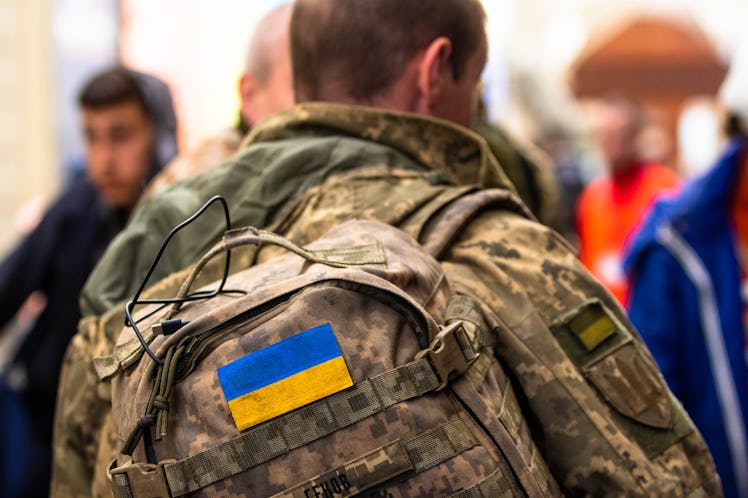
Here’s Why Ukraine Wants To Join NATO So Bad — And Why It Could Be Risky
It could trigger an all-out war.
Since Russia invaded Ukraine on Feb. 24, people all over the world have been witnessing tragedy after tragedy unfold: Over two million Ukrainian people have fled their homes to avoid war and violence, and many more are internally displaced by the fighting. Amid this conflict, Ukrainian President Volodymyr Zelenskyy has urged the North Atlantic Treaty Organization (NATO) to admit the nation as a member — but what does that mean, and what would happen if, well, it happened? Here’s what you need to know about Ukraine’s relationship with NATO, according to the experts.
In a March 20 interview with CNN, Zelenskyy called for Ukraine to be accepted as a new member of NATO, the mutual defense alliance of European and North American nations. “I'd like to receive security guarantees for my country, for my people. If NATO members are ready to see us in the alliance, then do it immediately. Because people are dying on a daily basis,” he said. And while he later added that he was grateful for the aid NATO has provided so far, he noted that if Ukraine had already been an alliance member, “a war wouldn't have started.”
To truly understand this crisis, you need to know some critical historical context between Russia, Ukraine, and NATO, which was founded after World War II specifically to defend the allied nations against the Soviet Union. As of 2022, NATO consists of 30 independent nations, including three nations that were once part of the Soviet Union: Estonia, Latvia, and Lithuania.
While joining NATO may seem like a solid idea on paper, Amy Verdun, Ph.D, professor of political science at the University of Victoria in Canada, explains it could lead to a more rapid escalation of aggression from Russia. “An attack on a NATO member is an attack on all,” says Verdun. According to article five of the NATO treaty, “an armed attack against one or more [nations] in Europe or North America shall be considered an attack against them all.” This means that if one NATO ally is under attack, all other NATO allies have a duty to come to their defense.
Because of this, “it’s understandable that the United States and the EU members are not immediately keen to make Ukraine, at this stage, a NATO member,” says Verdun. “That would mean the scope of the invasion [of Ukraine] and the hostilities could reach much further.”
It makes sense that Zelenskyy would call for aid from any possible allies — as of March 21, U.S. officials have reported that 2,000 to 4,000 Ukrainian troops have been killed, while civilian casualties have climbed to at least 1,200, per CBS News. “This crisis right now is very urgent,” says Verdun. “It’s a fast-burning crisis.” But even if the political will from current NATO members was in favor of Ukraine’s membership, conflict is much more complex than simply waiting for NATO to induct Ukraine.
Verdun explains that Ukraine’s improving ties with Western and European countries is what fanned the flames of conflict in the first place. “Russia felt threatened by Ukraine coming closer to the [West],” Verdun says. Russian President Vladimir Putin has long asserted that Ukraine should be part of Russia, and under Russia’s cultural and political control. Verdun cites 2014’s Maidan Revolution as an example of the cultural shift: In November 2013, public unrest flared in response to President Viktor Yanukovych’s sudden decision to choose closer ties with Russia instead of signing the European Union–Ukraine Association Agreement. Feeling like their government was corrupted by Russian political influence, Ukrainian protestors staged a revolt in Kyiv that culminated in Yanukovych’s ousting. “That is one of the periods that is quite important for understanding the current invasion — the concern Russia has that Ukraine is moving closer to the West.”
And when Ukraine moved closer toward a NATO membership through the enhanced opportunity partner interoperability program in 2020, the threat of hostility from Russia became more and more pointed, until it came to a head as an all-out invasion on Feb. 24.
Adding to the complication, it would simply take too long for Ukraine to be admitted to NATO during this rapidly escalating crisis. While the country has already courted membership with the alliance through NATO's enhanced opportunity partner interoperability program, there’s still a long list of criteria it must meet to become an official member, which usually takes years.
But while Zelenskyy evaluates the possibility of negotiations with Putin, it’s clear he doesn’t expect his country to join NATO any time soon. "For years we have been hearing about how the door is supposedly open [to NATO membership] but now we hear that we cannot enter. And it is true, and it must be acknowledged," he said during a March 15 address to leaders of the British-led Joint Expeditionary Force. If negotiations with Russia don’t come to a peaceful resolution, Zelenskyy states, “that would mean that this is a third World War.”
So if NATO isn’t a viable option, what exactly is on the table when it comes to aiding Ukraine? For starters, the United States seems to be putting its money where its mouth is. As of March 16, President Joe Biden has pledged “an additional $800 million in security assistance to Ukraine, bringing the total U.S. security assistance committed to Ukraine to $1 billion in just the past week, and a total of $2 billion since the start of the Biden Administration.” Additionally, Biden has applied pressure with economic sanctions against Russia to specifically target Russian oligarchs and government officials. While the outcome of these measures are ultimately unclear, one thing is certain: Ukrainian people are suffering, and need help sooner rather than later.